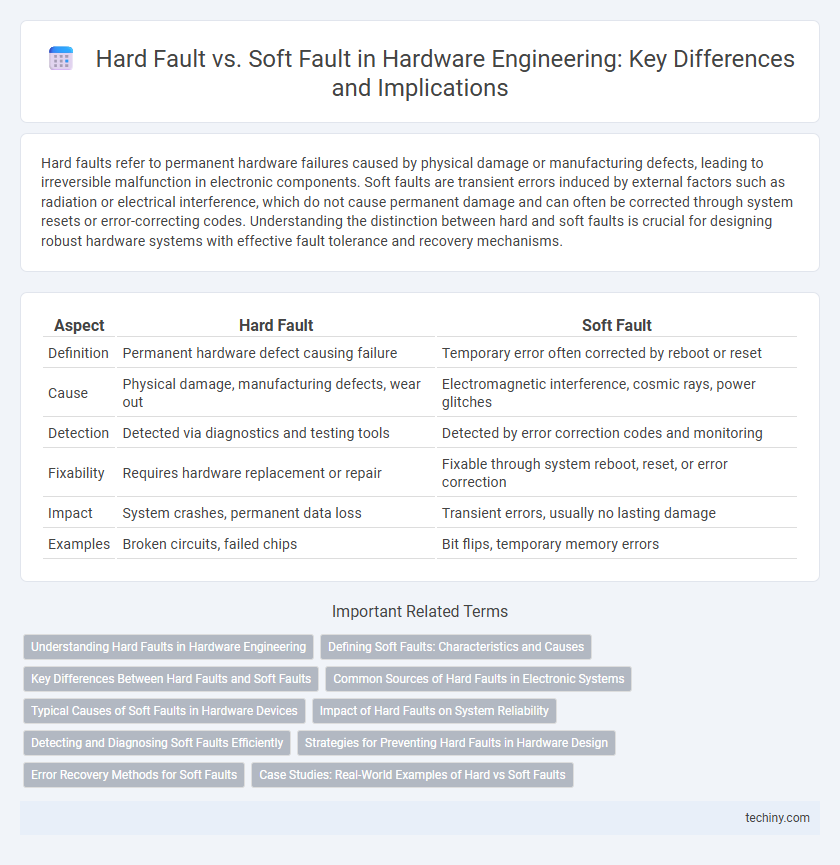Hard faults refer to permanent hardware failures caused by physical damage or manufacturing defects, leading to irreversible malfunction in electronic components. Soft faults are transient errors induced by external factors such as radiation or electrical interference, which do not cause permanent damage and can often be corrected through system resets or error-correcting codes. Understanding the distinction between hard and soft faults is crucial for designing robust hardware systems with effective fault tolerance and recovery mechanisms.
Table of Comparison
| Aspect | Hard Fault | Soft Fault |
|---|---|---|
| Definition | Permanent hardware defect causing failure | Temporary error often corrected by reboot or reset |
| Cause | Physical damage, manufacturing defects, wear out | Electromagnetic interference, cosmic rays, power glitches |
| Detection | Detected via diagnostics and testing tools | Detected by error correction codes and monitoring |
| Fixability | Requires hardware replacement or repair | Fixable through system reboot, reset, or error correction |
| Impact | System crashes, permanent data loss | Transient errors, usually no lasting damage |
| Examples | Broken circuits, failed chips | Bit flips, temporary memory errors |
Understanding Hard Faults in Hardware Engineering
Hard faults in hardware engineering refer to permanent defects in physical components such as damaged circuits, broken connections, or failed semiconductor elements. These faults cause persistent failures that remain until the faulty hardware is repaired or replaced, distinguishing them from transient soft faults triggered by environmental conditions or temporary glitches. Detecting hard faults involves techniques like fault injection, built-in self-test (BIST), and diagnostic testing to isolate and rectify hardware malfunctions effectively.
Defining Soft Faults: Characteristics and Causes
Soft faults in hardware engineering refer to transient errors that do not cause permanent damage to the system or component. They are characterized by their temporary nature, often triggered by external factors such as electromagnetic interference, radiation, or voltage fluctuations. These faults usually resolve on their own or can be corrected through error detection and correction mechanisms without requiring hardware replacement.
Key Differences Between Hard Faults and Soft Faults
Hard faults in hardware engineering refer to permanent physical defects in components such as broken circuits or damaged memory cells, often requiring hardware replacement. Soft faults, by contrast, are transient errors caused by external conditions like radiation or power fluctuations, typically correctable through resets or error-correcting codes. The key difference lies in persistence and recoverability: hard faults cause irreversible damage, while soft faults produce temporary malfunctions without physical harm.
Common Sources of Hard Faults in Electronic Systems
Common sources of hard faults in electronic systems include physical damage such as broken or cracked components, solder joint failures, and corrosion on circuit boards. Environmental factors like extreme temperature variations, mechanical shocks, and moisture ingress frequently cause irreversible hardware malfunctions. Faulty manufacturing processes and electrostatic discharge (ESD) events also contribute significantly to hard faults by permanently compromising device integrity.
Typical Causes of Soft Faults in Hardware Devices
Typical causes of soft faults in hardware devices include transient electrical disturbances, such as voltage spikes, electromagnetic interference, or cosmic ray strikes, which temporarily disrupt normal operation without causing permanent damage. Soft faults often result from environmental factors like temperature fluctuations or power supply instability, leading to intermittent errors in memory cells or processing units. These faults can typically be resolved through system resets or error correction protocols, distinguishing them from hard faults that require physical repair or component replacement.
Impact of Hard Faults on System Reliability
Hard faults, caused by permanent physical defects such as damaged circuits or broken connections, significantly degrade system reliability by causing irreversible failures and system downtime. These faults necessitate hardware replacement or repair, leading to increased maintenance costs and reduced operational availability. In contrast to soft faults, which are transient and can often be corrected through error correction techniques, hard faults compromise the integrity of critical components, resulting in persistent system instability.
Detecting and Diagnosing Soft Faults Efficiently
Soft faults in hardware engineering are transient issues caused by environmental factors or temporary glitches, making them harder to detect compared to hard faults, which result from permanent physical damage. Efficient detection of soft faults relies on advanced diagnostic tools such as run-time monitoring, error-correcting codes (ECC), and built-in self-test (BIST) mechanisms that continuously check system integrity. Implementing machine learning algorithms to analyze patterns in error logs enhances the accuracy of soft fault diagnosis and reduces system downtime.
Strategies for Preventing Hard Faults in Hardware Design
Preventing hard faults in hardware design requires implementing robust error detection and correction mechanisms such as ECC memory and parity checks. Employing high-quality components with stringent manufacturing standards reduces susceptibility to permanent failures caused by physical defects. Designing for redundancy and incorporating comprehensive stress testing during development further enhances hardware reliability against hard faults.
Error Recovery Methods for Soft Faults
Soft faults in hardware engineering are transient errors caused by temporary disturbances such as radiation or power fluctuations, and they do not damage the physical components. Error recovery methods for soft faults primarily involve error detection and correction techniques like Error-Correcting Code (ECC) memory, watchdog timers, and retry mechanisms to restore correct system operation without hardware replacement. Implementing redundancy architectures, such as Triple Modular Redundancy (TMR), enhances fault tolerance by enabling the system to mask or recover from soft faults dynamically.
Case Studies: Real-World Examples of Hard vs Soft Faults
In hardware engineering case studies, hard faults often manifest as permanent failures such as a burnt-out resistor or a cracked PCB trace, causing consistent malfunction until physical repair is performed. Soft faults typically involve transient errors like bit flips in memory due to cosmic rays or electromagnetic interference, which can be corrected through error detection and correction mechanisms. Real-world examples include hard faults in aerospace electronics requiring component replacement and soft faults in data centers resolved by ECC memory and system resets.
Hard fault vs Soft fault Infographic

 techiny.com
techiny.com